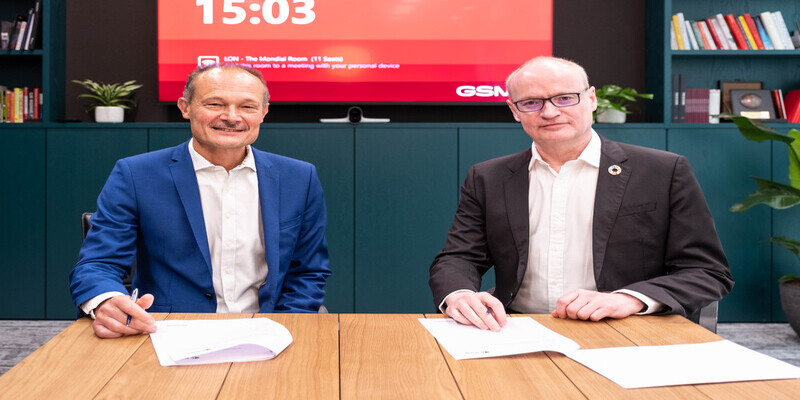New Collaboration Will Look to Accelerate Advancements in Satellite and Terrestrial Communications Network Integration
12 July 2023, OXFORDSHIRE: The GSMA and European Space Agency (ESA) today signed a Memorandum of Intent (MOI) to bring the mobile and satellite industries closer together to collaborate on developing new, innovative satellite and terrestrial networks technologies.
The ambition of the partnership is to further strengthen the competitiveness of both mobile and satellite network industries, by creating an ecosystem which can fast-track the development of new complimentary technology solutions for businesses and consumers. The two organisations will join efforts to speed-up innovation when it comes to integrating satellite communications with 5G and future 6G networks.
Key to this collaboration will be the GSMA Foundry innovation accelerator which brings together the mobile network operator community, and the wider technology industry, to accelerate cross-industry collaboration and advancements in mobile communication. As the ‘Home of Mobile Innovation,’ GSMA Foundry helps members forge the digital future by rapidly developing real-world solutions to industry challenges, nurture innovative ideas through initial commercial trials, and scale proven solutions at a regional and global level.
GSMA Foundry will work closely with ESA’s 5G/6G Hub, based at ESA’s European Centre for Space Applications and Telecommunications (ECSAT) based in Harwell, Oxfordshire. The ESA Hub brings together the satellite industry to work on new collaborative and innovative programmes. Benefiting from the support of the UK Space Agency (UKSA) the Hub fits into the UK Government’s 5G and 6G strategy.
As part of the MOI, the GSMA and ESA aim to collaborate and share knowledge, ideas, and outcomes of trials, which can help better integrate 5G and future 6G communications with non-terrestrial networks. This will be done through joint GSMA Foundry and ESA technology challenges supporting terrestrial and non-terrestrial networks, as well as through joint events and promotions at conferences, such as Mobile World Congress.
To bring added support to the partnership, GSMA Intelligence (GSMAi) will add research and insights on key focus topics.
Recent research findings by GSMAi showed that the increased adoption and integration of satellite technologies by the communications industry could lead to potential revenue gains of $35bn by 2035 (a 3% uplift on telecommunications industry revenues).
Speaking following the signing of the MOI at ECSAT in Oxfordshire, Alex Sinclair, Chief Technology Officer at the GSMA said: “By collaborating more closely with the European Space Agency, and its satellite network operator ecosystem, we hope to accelerate the immense potential satellite and terrestrial telecommunications networks can create for consumers and businesses when they are more closely connected. By working together, we can help the communications industry bring innovative solutions to market, which in turn will create tremendous benefits to society by connecting even more people, wherever they are in the world.”
Antonio Franchi, Head of Space for 5G and 6G Strategic Programme, ESA, said: “Collaboration is key to telecommunications innovation and, from our 5G/6G Hub, we are fostering industry partnerships to advance the 5G digital transformation of society and industry. We look forward to working with GSMA to explore and realise the huge potential of next-generation satellite-enabled connectivity.”
-ENDS-
About GSMA
The GSMA is a global organisation unifying the mobile ecosystem to discover, develop and deliver innovation foundational to positive business environments and societal change. Our vision is to unlock the full power of connectivity so that people, industry, and society thrive. Representing mobile operators and organisations across the mobile ecosystem and adjacent industries, the GSMA delivers for its members across three broad pillars: Connectivity for Good, Industry Services and Solutions, and Outreach. This activity includes advancing policy, tackling today’s biggest societal challenges, underpinning the technology and interoperability that make mobile work, and providing the world’s largest platform to convene the mobile ecosystem at the MWC and M360 series of events.
We invite you to find out more at gsma.com
For more information on GSMA Foundry, please visit: gsma.com/foundry
About the European Space Agency
The European Space Agency (ESA) provides Europe’s gateway to space.
ESA is an intergovernmental organisation, created in 1975, with the mission to shape the development of Europe’s space capability and ensure that investment in space delivers benefits to the citizens of Europe and the world.
ESA has 22 Member States: Austria, Belgium, the Czech Republic, Denmark, Estonia, Finland, France, Germany, Greece, Hungary, Ireland, Italy, Luxembourg, the Netherlands, Norway, Poland, Portugal, Romania, Spain, Sweden, Switzerland and the United Kingdom. Slovenia, Latvia and Lithuania are Associate Members.
ESA has established formal cooperation with five Member States of the EU. Canada takes part in some ESA programmes under a Cooperation Agreement.
By coordinating the financial and intellectual resources of its members, ESA can undertake programmes and activities far beyond the scope of any single European country. It is working in particular with the EU on implementing the Galileo and Copernicus programmes as well as with Eumetsat for the development of meteorological missions.
Learn more about ESA at www.esa.int


